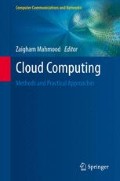Abstract
With the convergence of several trends such as digitization of the value chains of several industries, increasing adoption of social media by Internet users, and pervasiveness of computing with processing in systems like automobiles and household appliances, there are new business and IT models emerging, including application marketplaces, industry business clouds, and Software as a Service. Also, there are new opportunities and technology challenges emerging, e.g., data deluge caused by data doubling every 2 years, with much more unstructured data being generated than structured data. With this background, the traditional architectural solutions and technologies are unable to meet the requirements of scenarios like application marketplaces involving hundreds of thousands of applications, e.g., in a mobile application store with millions of low-value transactions that are highly unpredictable. To this end, architectural solutions leveraging cloud platforms [1] are being evaluated to meet such requirements. Also, traditional data storage, search, and processing technologies (e.g., relational databases) are unable to scale economically to meet these increasing data volumes and varieties at the expected velocity of response times. Internet companies like Google, Yahoo, and Facebook that have been dealing with such extreme data requirements have developed Big data solutions and technologies like NoSQL, Distributed File Systems, and MapReduce frameworks that can leverage commodity hardware and provide the needed scalability and fault tolerance. These architectural solutions and technologies are now being made available for solution architects through open source, commercial technology, and cloud providers. There are reusable architectural solution patterns at infrastructure and software platform/application layers. This chapter describes some of the common emerging business scenarios and architectural solution patterns at platform and application layers leveraging the cloud [1] and Big data technologies.
Access this chapter
Tax calculation will be finalised at checkout
Purchases are for personal use only
References
Mell, P., Grance, T.: The NSIT definition of cloud computing. http://csrc.nist.gov/publications/nistpubs/800-145/SP800-145.pdf (2011)
Guest, S.: 5 cloud computing patterns along with examples and Azure solutions. http://www.infoq.com/presentations/Patterns-for-Cloud-Computing (2010)
Amrhein, D., Anderson, P.: Cloud computing use cases. http://www.opencloudmanifesto.org/Cloud_Computing_Use_Cases_Whitepaper-2_0.pdf (2009)
CA Technologies: IT optimization through workload automation. http://whitepapers.businessweek.com/detail/RES/1335968686_109.html (2012)
Subramanian, K.: Hybrid clouds: a whitepaper sponsored by Trend Micro Inc. http://www.trendmicro.com/cloud-content/us/pdfs/business/white-papers/wp_hybrid-clouds-analyst-ksubramanian.pdf (2011)
Hong Cai.: A transparent approach of enabling SaaS multi-tenancy in the cloud. In: 6th World Conference on Services. http://ieeexplore.ieee.org/stamp/stamp.jsp?tp=&arnumber=5575773&isnumber=5575460 (2010)
Ekanayake, J., Fox, G.: High Performance Parallel Computing with Cloud and Cloud Infrastructure. Department of Computer Science, Indiana University, Bloomington. http://grids.ucs.indiana.edu/ptliupages/publications/cloudcomp_submission.pdf (2010)
Papuzzo, G., Spezzano, G.: Autonomic management of workflows on hybrid Grid-Cloud Infrastructure. In: 7th International Conference on Network and Service Management (CNSM). http://ieeexplore.ieee.org/stamp/stamp.jsp?tp=&arnumber=6104004&isnumber=6103944 (2011)
Miceli, C., Miceli, M., Jha, S., Kaiser, H., Merzky, A.: Programming abstractions for data intensive computing on clouds and grids. In: 9th IEEE/ACM International Symposium on Cluster Computing and the Grid, CCGRID. http://dx.doi.org/10.1109/CCGRID.2009.87 (2009)
Doddavula, S., Subramanian, R., Deb, B.: What is beyond operational efficiency? http://www.infosys.com/cloud/resource-center/documents/beyond-operational-efficiency.pdf (2009)
Fehling, C., Retter, R.: Cloud Computing Patterns: http://cloudcomputingpatterns.org/ (2011)
Ricky Ho.: Cloud computing patterns. http://architects.dzone.com/news/cloud-computing-patterns (2009)
Author information
Authors and Affiliations
Corresponding author
Editor information
Editors and Affiliations
Rights and permissions
Copyright information
© 2013 Springer-Verlag London
About this chapter
Cite this chapter
Doddavula, S.K., Agrawal, I., Saxena, V. (2013). Cloud Computing Solution Patterns: Application and Platform Solutions. In: Mahmood, Z. (eds) Cloud Computing. Computer Communications and Networks. Springer, London. https://doi.org/10.1007/978-1-4471-5107-4_11
Download citation
DOI: https://doi.org/10.1007/978-1-4471-5107-4_11
Published:
Publisher Name: Springer, London
Print ISBN: 978-1-4471-5106-7
Online ISBN: 978-1-4471-5107-4
eBook Packages: Computer ScienceComputer Science (R0)

